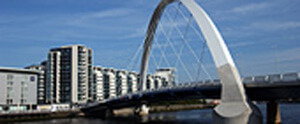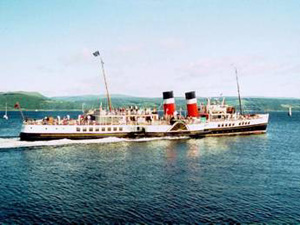The Glasgow Scotland Report Sponsored By

The Glasgow Report will bring you weekly updates revolving around the boating activities in and around Glasgow and Scotland. Along with those updates will be an on-going report on the major part that Glasgow played in the development of the steam engine.
 Photo
Credit City of Glasgow Photo
Credit City of Glasgow
Bridges
I suppose Glasgow is like any other big European city, it has lots of bridges which are not very far apart. The locals have strange names for them; the Squinty Bridge and the Spiky Bridge are two of them. The Squinty Bridge is really called the Clyde Arc. It is built at a strange angle and so it looks Squint. It connects Govan with the City Centre and can be seen on the BBC news.
Nobody seems to know what the Spiky Bridge’s real name is. Other bridges are the Kingston Bridge, which is the most used bridge by people coming from the South Side of the city and the railway bridge. Every train that goes to Glasgow Central Station passes over this bridge.
Central Station
Central Station is not huge compared to other stations but it is very nice. There are about 15 platforms and lots of shops. On week days the station is filled with St Aloysius’ College pupils who take the train, I being one of them. The London sleeper leaves from Central and I think it would be great fun to go on it.
There are many different trains that go in and out of Central. Some have double doors, some single and others are sleepers. None, however, are double-deckers and there will never be any as railway bridges are too low for them. The trains go all over the city and all over the country.
There is also Queen Street Station, Charing Cross Station and many subway stations. There are also alot of buses and many people take public transport to work.
 Photo
Credit City of Glasgow Photo
Credit City of Glasgow
Glasgow City Council acted as agent for Scottish Enterprise Glasgow to build a new road bridge across the River Clyde. It links Finnieston Street on the north bank to Govan Road/Pacific Quay on the south. The project aims to
* Provide better access to Pacific Quay;
* Attract more than 3,500 jobs to the area;
* Regenerate areas of vacant land on both sides of the river;
* Stimulate wider economic benefits to areas beyond Pacific Quay;
* Improve both public and private transport links for the benefit of tourism and visitor attractions and
* Provide an instantly recognisable gateway to the City
This is the first new road bridge over the River Clyde to be built since 1969. It features a tied arch design, which gives an instantly recognisable gateway into the city from Pacific Quay.
The bridge has four traffic lanes – two dedicated to public transport and two for private and commercial vehicles. It also features pedestrian and cycle paths.
Ship Building Part II
by Caroline McWilliams
The Waverly

Looking out over the Clyde you often see the Waverly, an old paddle steamer. The Waverly gives tours to Dunoon, Rothesay, Largs and Ayr. It is quite a small ship and it can get underneath Glasgow’s extensive collection of bridges.
When on the Waverly you can get off at various destinations and explore. The ship passes Ayrshire’s beautiful Culzean Castle and goes to Rothesay, a little island off the coast of Scotland.
The Waverly is a beautiful ship, with two funnels and some very pretty lifeboats. It is very old now but will probably run for many years to come.
Ship Building Part I
by Caroline McWilliams
Glasgow used to be famous for its ship building companies. It became the second city of the British empire because of this. Some of the biggest and most well known ships in the world were built there, including ‘the Lusitania’, ‘the Queen Mary’, ‘the Queen Elizabeth’ and ‘the Royal Yacht Britannia’.
Glasgow is the lowest bridging point of the River Clyde which at its deepest point is 2000 ft. Naturally ships were built there. Steel replaced iron and Glasgow prospered. However during WW2, Clydebank (a suburb of Glasgow, near to the Clyde) was bombed and ship building has since declined. Occasionally military ships are built there and ‘the Tall Ship’ which is an old sail ship, still attracts visitors.
Dinghy Digest ®
|


